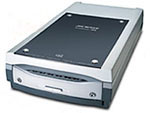
Microtek ScanMaker i800-- A Scanner for Everyone
By MIKE PASINI
Editor
The Imaging Resource Digital Photography Newsletter
Microtek (http://www.microtek.com/) announced its ScanMaker i800 at Photoshop World in Sept. 2005 and is just shipping a Pro version with upgraded software to read the included IT8 targets. We received an early review unit which sat by our side for a couple of months handling our routine scanning tasks.
Microtek (http://www.microtek.com/) announced its ScanMaker i800 at Photoshop World in Sept. 2005 and is just shipping a Pro version with upgraded software to read the included IT8 targets. We received an early review unit which sat by our side for a couple of months handling our routine scanning tasks.
It handled everything we threw at it -- line art, 35mm negatives, slides, prints -- rather effortlessly, regardless of which scanning application we favored at the moment. Not only is the i800 versatile, but it's also affordable at just $399.99 list.
What's affordable about $400 list? How about a Dmax of 4.0, 48-bit color and 9600x4800 dpi optical resolution on a legal-sized scanning bed with your choice of High-Speed USB 2.0 or FireWire ports?
Inexpensive flatbeds strain to get their Dmax (the maximum recordable density with 4.0 being very black) into the high threes, fine for the 2.0 dynamic range (Dmax minus the rarely stated Dmin) you need to scan reflective material. But slides can be up around 3.2 to no more than 4.0 (and negs a little less). Given a Dmin of around 0.3, let's say, anything less than a Dmax of 4.0 is going to have trouble capturing shadow detail in slides. For more about Dmax, see our April 15, 2005 issue (http://www.imaging-resource.com/IRNEWS/index-arch.html).
An inexpensive flatbed may have an optical resolution as low as 1200-dpi (although the trend is upward). If you scan a 35mm film frame at that resolution, your maximum enlargement for a 300-dpi dye sub printer is 4x6. To get an 8x10, you have to be able to scan 2400 dpi. So the low number of the scanner's optical resolution should be a least 2400 for film. Which happens to be the current limit for 8.5-inch wide flatbeds. Manufacturers achieve resolutions greater than that by stacking CCDs at a half-pixel offset.
The i800Shadowed by the i900 behind it.
What's affordable about $400 list? How about a Dmax of 4.0, 48-bit color and 9600x4800 dpi optical resolution on a legal-sized scanning bed with your choice of High-Speed USB 2.0 or FireWire ports?
Inexpensive flatbeds strain to get their Dmax (the maximum recordable density with 4.0 being very black) into the high threes, fine for the 2.0 dynamic range (Dmax minus the rarely stated Dmin) you need to scan reflective material. But slides can be up around 3.2 to no more than 4.0 (and negs a little less). Given a Dmin of around 0.3, let's say, anything less than a Dmax of 4.0 is going to have trouble capturing shadow detail in slides. For more about Dmax, see our April 15, 2005 issue (http://www.imaging-resource.com/IRNEWS/index-arch.html).
An inexpensive flatbed may have an optical resolution as low as 1200-dpi (although the trend is upward). If you scan a 35mm film frame at that resolution, your maximum enlargement for a 300-dpi dye sub printer is 4x6. To get an 8x10, you have to be able to scan 2400 dpi. So the low number of the scanner's optical resolution should be a least 2400 for film. Which happens to be the current limit for 8.5-inch wide flatbeds. Manufacturers achieve resolutions greater than that by stacking CCDs at a half-pixel offset.
The i800Shadowed by the i900 behind it.

No comments:
Post a Comment